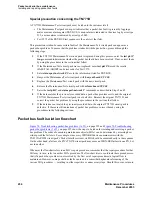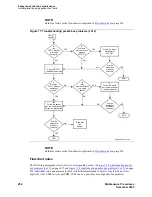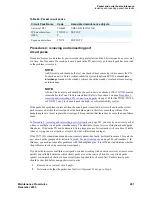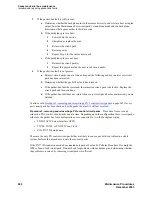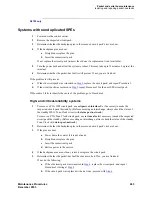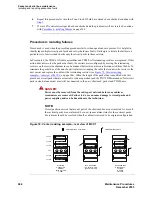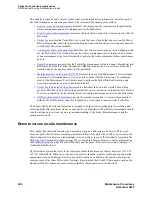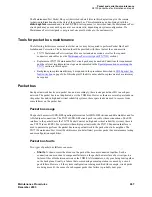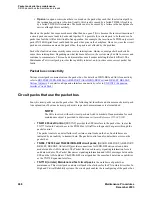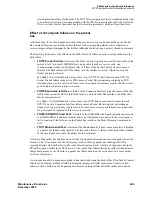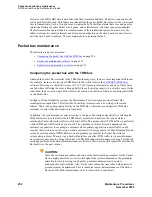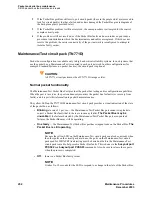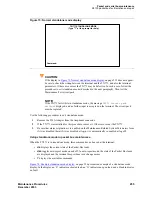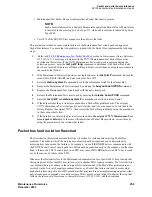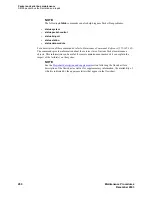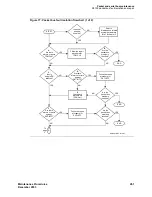
Packet and serial bus maintenance
S8100 packet bus fault isolation and repair
246
Maintenance Procedures
December 2003
This chapter is organized into several sections that provide introductory information, as well as packet
bus fault isolation and correction procedures. The sections of the chapter are as follows:
•
Remote versus on-site maintenance
discusses the strategy and the requirements for performing
remote maintenance and on-site maintenance for the Packet Bus.
•
Tools for packet bus maintenance
discusses the tools that are needed to isolate and correct Packet
Bus faults.
•
describes the Packet Bus, its use, and the types of faults that can occur on the Packet
Bus. A diagram that shows the physical and logical connections between circuit packs connected
to the Packet Bus is also included.
•
Circuit packs that use the packet bus
describes the various circuit packs, ports, and endpoints that
use the Packet Bus. The section discusses how these maintenance objects interact, how a failure
of one maintenance object can affect another, and also the failure symptoms of these maintenance
objects.
•
describes the Packet Bus maintenance software strategy. Similarities and
differences between the Packet Bus and the TDM Bus are discussed. An overview of the Fault
Isolation and Correction Procedures is also presented.
•
Maintenance/Test circuit pack (TN771D)
discusses the use of the Maintenance/Test circuit pack
in normal switch maintenance, as well as its role in Packet Bus fault isolation. The standalone
mode of the Maintenance/Test (which is used to perform the Packet Bus Fault Isolation and
Correction procedures on-site) is discussed in detail.
•
Packet bus fault isolation flowchart
presents a flowchart that is used to isolate a Packet Bus
problem. This flowchart is the starting point for this process, and it is used to determine if a failure
of service is caused by the Packet Bus itself or by another maintenance object on the Packet Bus.
•
S8100 packet bus fault correction
presents the procedures required to correct either a problem
with the Packet Bus itself or one that is caused by a circuit pack connected to the Packet Bus.
The Packet Bus Fault Isolation Flowchart is intended to be the normal starting point for isolating and
resolving Packet Bus problems. However, anyone who is unfamiliar with Packet Bus maintenance should
read the introductory sections to gain a good understanding of the Packet Bus maintenance and the
procedures involved.
Remote versus on-site maintenance
Most packet bus fault isolation and repair procedures require a technician to be on-site. This is true
because a packet bus failure is caused by a hardware failure of the packet bus itself or by a circuit pack
that is connected to it. However, initial diagnoses can be made via use of the flowchart presented in the
Packet bus fault isolation flowchart
on page 259 section of this chapter. However, before implementing
the
on page 253 (described later) and the Packet Bus Fault Correction Procedure, a
technician must be on-site.
The flowchart as presented refers to the repair procedures in Maintenance Alarms Reference (555-245-
102) for various MOs. When one of the decision points is reached, a remote technician can refer to the
appropriate section and attempt to resolve any fault conditions. In addition, the remote technician can
examine some of the other MOs on the flowchart. Keep in mind that if an MO that appears early on the
flowchart fails, this failure can cause alarms with MOs that appear later in the flowchart.
Содержание CMC1
Страница 1: ...Maintenance Procedures 555 245 103 Issue 1 1 December 2003 ...
Страница 14: ...Contents 14 Maintenance Procedures December 2003 ...
Страница 158: ...Server initialization recovery and resets System resets 158 Maintenance Procedures December 2003 ...
Страница 416: ...Additional maintenance procedures IP Telephones 416 Maintenance Procedures December 2003 ...
Страница 426: ...Index X 426 Maintenance Procedures December 2003 ...



